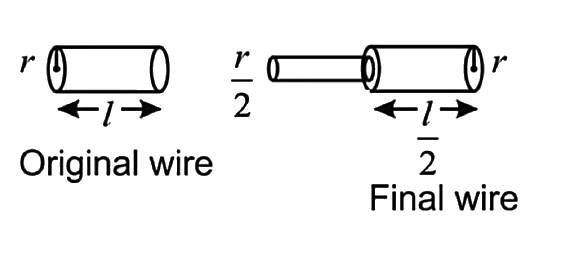A resistance 10Ω is stretched to twice its original length . The resistance of the stretched wire is
10Ω
20Ω
40Ω
80Ω
To find the resistance of a wire that has been stretched to twice its original length, we can follow these steps:
Step 1: Understand the relationship between resistance, resistivity, length, and cross-sectional area.
The resistance R of a wire is given by the formula:
R=ρLA
where:
- R is the resistance,
- ρ is the resistivity of the material,
- L is the length of the wire,
- A is the cross-sectional area.
Step 2: Recognize that the volume of the wire remains constant when stretched.
The volume V of the wire can be expressed as:
V=A×L
When the wire is stretched to twice its original length, the new length L′ becomes:
L′=2L
Since the volume remains constant, we have:
A×L=A′×L′
where A′ is the new cross-sectional area after stretching.
Step 3: Relate the new area to the original area.
Substituting L′ into the volume equation gives:
A×L=A′×(2L)
From this, we can solve for A′:
A′=A2
This means that when the wire is stretched, its cross-sectional area is halved.
Step 4: Substitute the new values into the resistance formula.
Now, we can calculate the new resistance R′ using the new length and new area:
R′=ρL′A′=ρ(2L)A2=2ρLA2=2ρL⋅2A=4ρLA
This shows that the new resistance R′ is four times the original resistance R.
Step 5: Calculate the new resistance.
Given that the original resistance R is 10Ω:
R′=4R=4×10Ω=40Ω
Final Answer:
The resistance of the stretched wire is 40Ω.
---
The resistance R of a wire is given by the formula:
R=ρLA
where:
- R is the resistance,
- ρ is the resistivity of the material,
- L is the length of the wire,
- A is the cross-sectional area.
The volume V of the wire can be expressed as:
V=A×L
When the wire is stretched to twice its original length, the new length L′ becomes:
L′=2L
Since the volume remains constant, we have:
A×L=A′×L′
where A′ is the new cross-sectional area after stretching.
Substituting L′ into the volume equation gives:
A×L=A′×(2L)
From this, we can solve for A′:
A′=A2
This means that when the wire is stretched, its cross-sectional area is halved.
Now, we can calculate the new resistance R′ using the new length and new area:
R′=ρL′A′=ρ(2L)A2=2ρLA2=2ρL⋅2A=4ρLA
This shows that the new resistance R′ is four times the original resistance R.
Given that the original resistance R is 10Ω:
R′=4R=4×10Ω=40Ω
The resistance of the stretched wire is 40Ω.
Similar Questions
Knowledge Check
A wire with 15ohm resistance is stretched by one tenth of its original length and volume of wire is kept constant. Then its resistance will be
A15.18ΩB81.15ΩC51.18ΩD18.15Ω
A wire of resistance 4Ω is stretched to twice its original length. In the process of stretching, its area of cross-section gets halved. Now, the resistance of the wire is
View SolutionA wire has a resistance of 10Ω. It is stretched by 1/10 of its original length. Then its resistance will be
View SolutionA wire is stretched to n times its length. Then the resistance now will be increase by
View SolutionIf a wire is stretched to four times its length, then the specific resistance of the wire will
View SolutionA wire of length l has a resistance R. If half of the length is stretched to make the radius half of its original value, then the final resistance of the wire is

View SolutionWhen a wire is stretched to double its length, then
View SolutionA metal wire of resistance 6Ω is stretched so that its length is increased to twice its original length. Calculate its new resistance.
View Solution
